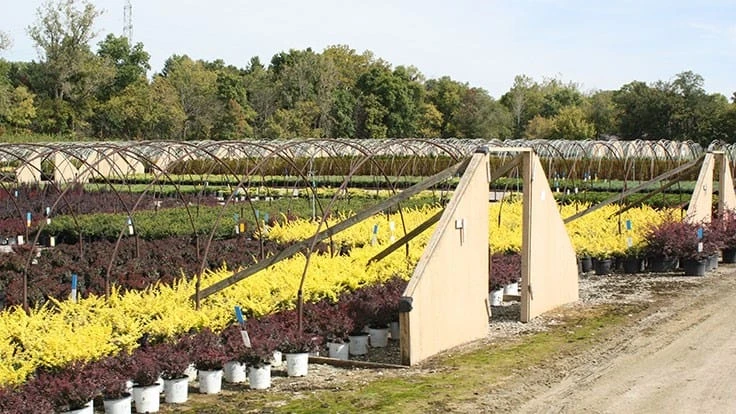

On Sunday, July 11, Joe Neal, professor of weed science and extension specialist at North Carolina State University, spoke to a crowd of growers at Cultivate'21 who are all facing the same problem: weeds. At his educational session, "Strategies to reduce weed control costs in container nurseries," Neal covered some of the most-common problem weeds and how growers can develop a plan to stop them.
Bittercress is the most-common cool-season weed and spurge is the most-common warm-season weed, Neal said. Spurge is particularly nefarious, requiring only five days to germinate.
Neal asked and answered the big weed control question during his talk: despite effective herbicides, why do weeds continue to emerge? In many cases, the answer is that growers are not rotating effectively.
Neal said that whoever’s in charge of herbicide application at your nursery needs to be adhering to the label. If you apply any herbicide more frequently than it’s meant to be applied, its efficacy will drop and your weeds will develop resistance. That’s how a once-stellar herbicide becomes useless. Commonly used herbicide Broadstar can have 2 applications per year. Barricade and Gemini: also 2 applications per year. Freehand and Tower: 2 applications per year. Snapshot and Gallery: 3 applications per year. Marengo: 2 applications per year.
“None of them say ‘6,’” Neal says.
The NC State Extension website has plenty of charts and sheets that growers can use to develop their own rotation plan, depending on which crops they grow. Check them out at his website: weeds.ces.ncsu.edu/weeds-herbicides.
Neal also discussed the importance of uniformity in herbicide distribution. A typical application has a 250% variation, he said. That means some plants are getting the correct dose but some may be getting two-and-a-half times more or less than the recommended dose. If you have a variable application rate, you’ll end up with variable weed control, he said.
Calibration of your spreader is a crucial step to improving uniformity. Consistent walking and handle speeds are important to achieving uniform distribution. Neal suggests using a metronome to ensure consistent walking speed. Neal said many growers balk at this and say applicators should just use their smartphone.
“How many of you out there handling pesticides would want to get your phone out and handle it? Don’t ask your employees to do that,” Neal said.

Smartphones are typically difficult to operate with gloves on, and PPE should definitely be used while applying herbicides. Neal suggests buying them a $15 metronome and clipping it to the spreader.
Neal also discussed how the path you take with a spreader affects herbicide distribution. Swath width and directional spreading are areas to address. For instance, if your beds are 10 feet wide with a 12-foot swath width, and you use the left, right and center rudder positions, you will have areas that have heavy herbicide coverage and areas with light coverage. Heavy herbicide coverage could injure crops sensitive to that particular product, and areas with light coverage will be more susceptible to weed infestations.
Neal found that this could be remedied by keeping your beds 6-8 feet wide and using only the center rudder position. Also, applicators should refill when the hopper gets to about 25% full.
Walking pattern also makes a difference. Instead of walking down one row and up the next, use the single direction, parallel pass method. Calibrate for half the dose, then walk the same path in opposite directions. In tests, Neal found that method resulted in a much more uniform herbicide distribution.
Another topic Neal covered in his Cultivate talk was the importance of weeding frequently vs. “when it’s weedy.”
If growers get proactive with their hand-weeding and remove weeds before they set seed, they can reduce labor costs. Neal discussed an experiment that chronicled the difference between hand-weeding a 250-container nursery every two weeks versus hand-weeding on an eight-week interval.
Neal said he often hears complaints from growers at this point, citing a lack of employees or not enough time to hand-weed every two weeks. However, he said that several nurseries of various sizes have implemented this process, and each have reported significant cost savings.
The more frequent hand-weeding, unsurprisingly led to a 50-80% reduction in weeds (depending on the site). However, it also averaged a 39% reduction in labor costs, due to the lower number of hours spent weeding.
When using the more frequent hand-weeding method, the largest labor savings will be obtained in crops or sites with high weed populations, long-term crops that will be in production at least 16 weeks, and during weather that is conducive to high weed growth.
The challenge with a higher-frequency hand-weeding program is labor management. If you happen to get busy with something else at the nursery and miss a cycle, Neal says it becomes very difficult to catch up. He suggests keeping the nursery clean through effective herbicide use and sanitation around the containers.

Explore the August 2021 Issue
Check out more from this issue and find your next story to read.
Latest from Nursery Management
- John Ruter shares UGA's latest woody and herbaceous ornamental plant breeding projects
- Conor Foy joins EHR's national sales team
- Pantone announces its 2026 Color of the Year
- Syngenta granted federal registration for Trefinti nematicide/fungicide in ornamental market
- Get to know Kayela Aeppli
- HILA 2025 video highlights: John Gaydos of Proven Winners
- Q&A with Justin Bartlett
- Be the best choice





